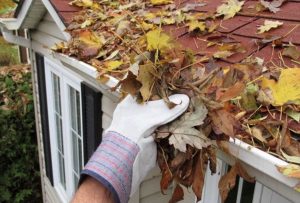
As the leaves begin to drop and the temperatures get a little cooler, you can be sure that Fall is right around the corner. This means it is time for some fall home maintenance!
Whether you love the summer sun, or you can’t wait for a crisp, cold winter, it is essential to make sure your property is prepared for the coming seasons. To avoid costly repairs and last-minute emergencies, be sure check these items before rain season is here.
Before it gets too cold, have your heating system inspected by a professional. This is important so that you can ensure that your furnace or heat pump is working well, is clean, and is in good repair for the highest efficiency in your home.
Clean your gutters and check your roof for repairs.
If your gutters are filled with leaves or debris, it’s more likely that you’ll increase damage to your roof, siding or wood trim. This can lead to leaks. Be sure that your gutters are clean and free of debris for the winter and that no shingles are missing from your roof.
Cover your patio furniture and/or store it for the winter.
One of my family’s first things we do as the winter months start to arrive is to clean and store our patio furniture. We try to find a nice day in the fall to scrub and clean chairs and fabric cushions and we cover our remaining patio furniture with outdoor covers to protect them from the harsh winter elements.
Check batteries in smoke alarms and carbon monoxide detectors
Before you turn on your furnace in the fall, it’s a good idea to take the time for an annual smoke alarm and carbon monoxide detector checkup.
Turn off outdoor faucets and disconnect hoses.
Water sitting in faucets and hoses outdoors can freeze, which can cause pipes to burst as the water expands. Be sure to disconnect the hoses and drain them before it starts to get cold. If you have any exposed water pipes in your basement, be certain to take the time to insulate them, as well. Many stores carry outdoor spicket insulator kits to further reduce the likelihood of pipe breaks.
Reverse ceiling fans.
While not necessary, taking the time to reverse your ceiling fans can create an updraft in your home to keep heat downward, which will help keep your home warmer and more energy efficient.
Caulk around doors and windows.
If you live in an older house, sometimes over the years you’ll notice your doors or windows have more of a draft. When we repainted the outside of our home, we took the time to re-caulk around the doors and windows, which eliminated the draft and therefore kept our house warmer. If you need more than caulking to help with drafts, consider draft stopper type items to put under or around your doors and windows to keep the warm air in and the cold air out.
Stow your mower and outdoor lawn and yard equipment.
Be sure that your outdoor items like mowers and weed eaters are put away for the winter. It’s also a good idea to drain the excess gas from them to add life to your equipment and protect your investment, so they work well next spring. If you have outdoor recreational items like pools or trampolines, take the time to winterize them and take them down before the cold months approach.
Wash your windows, screens, and insulate old windows.
This is only nice because then you can go into the winter and enjoy the holidays with nice, clean windows. It can also be done in the spring though, too, if preferable. There are lots of ways to insulate older windows to keep things warmer, but often times a simple shade or curtain panel can help reduce heat loss by 10% or more than an untreated window!
Change your furnace filter and check your vents.
At the start of every fall, we always prioritize changing our furnace filter. It’s also important to check your vents to make sure that you feel air flow coming from them and that they aren’t blocked.
Have your chimney cleaned, if applicable.
If you have a chimney, hire someone to clean and inspect it before starting your cozy winter fires.
Walk around your house to check for proper grading and drainage.
Ensure that there aren’t gaps around your home’s foundation where water could pool up or freeze. This helps keep your basement dry through the winter. If you have mulching or landscaping, make sure your flower beds are sending water away from your house, rather than up against it.


 Facebook
Facebook
 X
X
 Pinterest
Pinterest
 Copy Link
Copy Link


